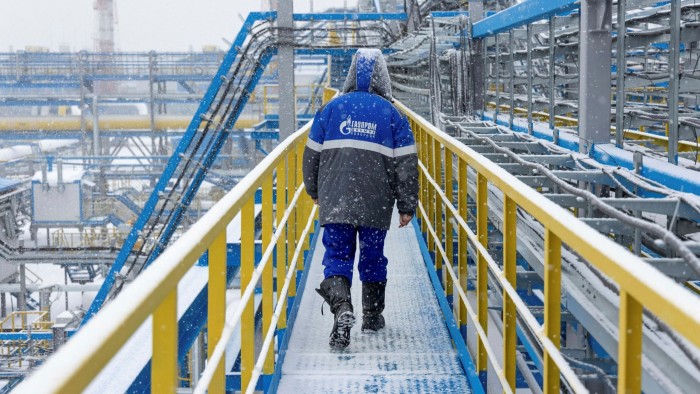How sanctions on Russian energy exports could work

Roula Khalaf, Editor of the FT, selects her favourite stories in this weekly newsletter.
The writer is founder and chief investment officer of Andurand Capital Management
It is probably not a coincidence that Russia decided to invade Ukraine at a time of extreme tightness for the energy markets.
European natural gas prices reached record highs before the invasion, trading above $300 per barrel of oil equivalent, or 10 times historical averages.
For many specialists, oil prices were destined to break all-time highs in 2022 due to very low oil inventories, minimum spare production capacity and an expected shortage of supply for the years to come. The only counter force in the short-term — apart from government-mandated demand restriction measures — comes from demand destruction, which happens at higher prices alongside a weaker economy.
For context from the recent past on how far prices can rise, Brent crude oil averaged $111 a barrel between January 2011 and July 2014, which corresponds to around $150 a barrel today after adjusting for inflation.
Despite the European debt crisis at that time, those prices did not have a meaningful impact on demand. However, they encouraged the US shale revolution, which subsequently capped prices as supply growth became significantly higher than global demand.
Higher oil prices in the deferred months of the futures curve will lead to increases in oil supply in 12 to 24 months in “brown field” sites of existing production but the reaction time is likely to be slower than in the past due to supply chain and labour supply issues. Large new projects will not come to the rescue due to lack of investment.
And now sanctions on Russian energy exports are being seriously considered. Those would trigger an economic cost for consumers, albeit lower than the alternative of continued bloodshed and war crimes in Ukraine and potentially beyond. The Russian regime with its Stalinist playbook has to be stopped, or at a minimum contained.
What would be the impact of a full EU embargo on Russian oil? Russia exports about 8mn barrels per day of crude oil, condensates and refined products around the world, of which 4.5mn b/d goes to Europe. Most of the eastern European refineries are landlocked and supplied by the Druzhba pipeline, and do not have alternative sources of supply. If there was an EU embargo that did not include exports via Druzhba, Russia would try to find alternative buyers for 3.5mn b/d but would face logistical issues such as a shortage of the Aframax ships that service its ports. As a result, it would probably not be able to find buyers for 2-2.5mn b/d.
A loss of 2.5 per cent of the world’s supply would be a difficult but not impossible task. The visibility of such a supply loss would encourage producers with spare capacity to use it right away, and US producers to increase production significantly.
Higher prices or government mandates to curtail energy use could lead to some demand reduction. A co-ordinated global release of strategic reserves would also give time for the market to adjust.
The ideal goal would be to lower Russian revenues while minimising the impact on oil flows. Two solutions could achieve this. The first one would be for the EU to impose price caps on Russian crude and oil products that are low enough to constrain investments in the military, but high enough to encourage Russia to maintain production and sell to European buyers — maybe around $50 per barrel. A similar effect could be achieved by a high European tax on Russian oil as advised by economist Ricardo Hausmann. The reduced competition for Russian energy would encourage Asian buyers to seek discounts as well.
Twice weekly newsletter

Energy is the world’s indispensable business and Energy Source is its newsletter. Every Tuesday and Thursday, direct to your inbox, Energy Source brings you essential news, forward-thinking analysis and insider intelligence. Sign up here.
Another solution would be to pay market prices, but with $50 a barrel going directly to Russian companies, and the balance on escrow accounts. The escrow money would then be released to Russia — net of reconstruction costs for Ukraine — after a rebuild of the trust with the Russian regime. Those solutions could naturally be extended to natural gas and coal.
Russia could refuse and decide to cut all energy exports to Europe. As a result, though, it would receive no money from Europe and lose all pricing power due to the lack of competition for its exports. This scenario would not be ideal for either party. Europe would be forced to adapt and accelerate its energy transition. Russia would get much lower revenues, and would have lost its biggest client forever.
In any scenario, it would be prudent for Europe to put its economy in war mode to accelerate its energy transition, boost its defence industry, become more self-reliant and work closely with North America for its energy security.
Andurand is an active trader in energy markets
Trade Secrets
The Trade Secrets Newsletter is the FT’s must-read email on the changing face of international trade and globalisation. Written by FT trade specialist Alan Beattie, it is delivered to your inbox every Monday. Sign up here
Comments